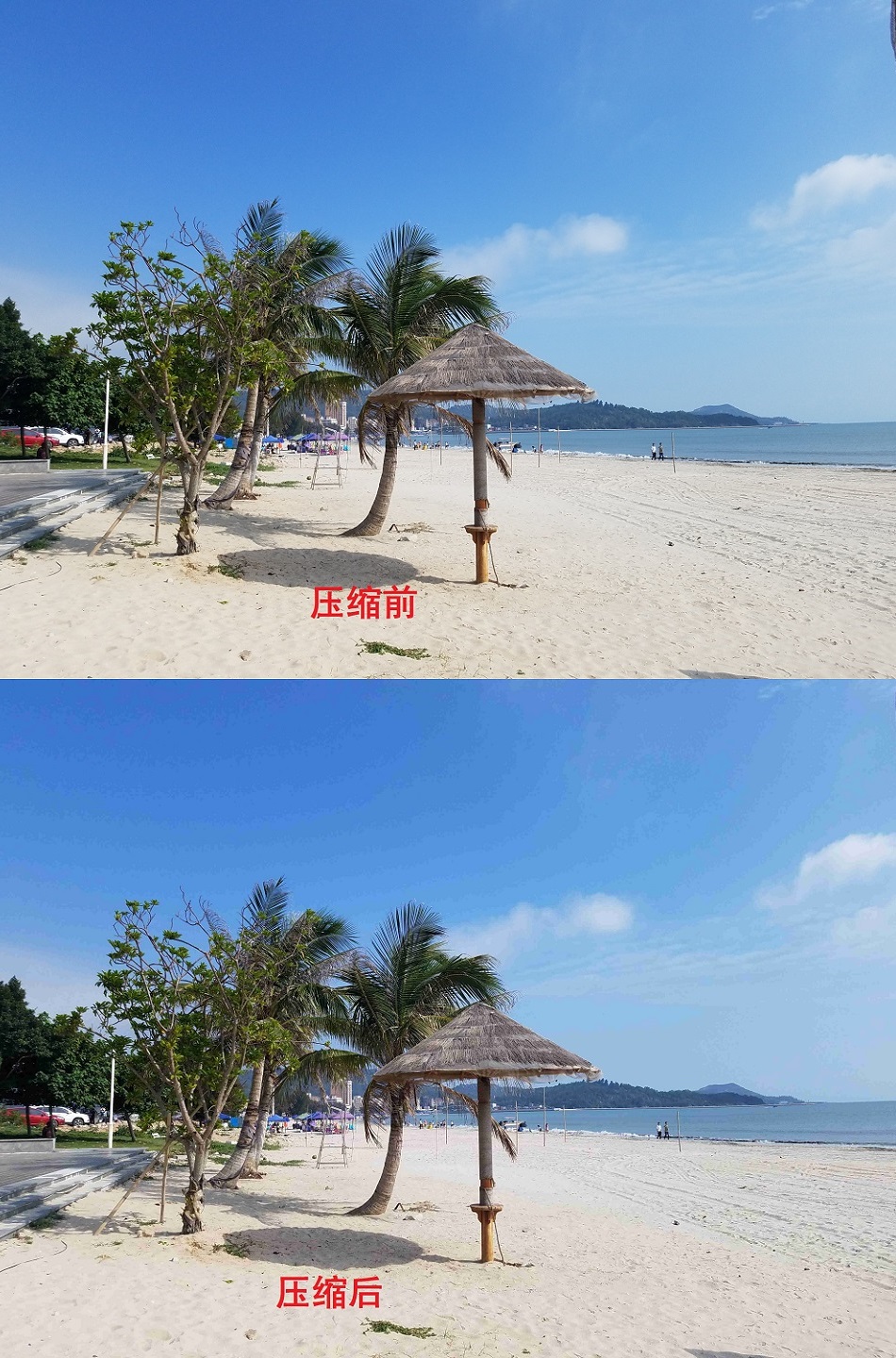最近公司要求图片上传需要压缩,以前直接使用组件不能满足使用了,于是决定自定义个图片上传组件。
可以实现动态传入url,设置压缩率,接收回传参数。 压缩也质量还不错。
先上效果图
效果如下
压缩质量还不错,4.37M到550k 压缩率更是达到了87% ,这省了不少流量和服务器硬盘啊,哈哈
1.组件html
定义了图片上传增加按钮,将原有的input标签样式进行了更改,图片显示也进行样式更改,利用vue2.0的v-for可以对图片进行动态增加和删除。
<div class="flex-img" id="img-arr">
<div class="upload-img" v-for="(imgstr,index) in imgStrArr"><i class="smui-icon smui-icon-cancel" @click="deleImg(index)"></i><img style="width:65px;height:65px" :src="imgstr"/></div>
<div class="upload-add-img" style="position:relative;">
<i class="smui-icon smui-icon-camera">
<div class="img-input">
<input type="file" id="img-upload-file" name="myfile" @change="UpladFile(url,quality)" class="img-file" accept="image/x-png, image/jpg, image/jpeg, image/gif"/>
</div>
</i>
</div>
</div>2.组件css
主要input标签样式进行了更改,布局使用了flex布局。flex布局非常适用于移动端布局。
添加图片按钮使用了相对布局包含绝对布局,将input和自定义的图标进行重合。
.img-upload{
.flex-img{
display: -webkit-box;
display: -ms-flexbox;
display: flex;
}
.upload-img{
margin-left: 10px;
margin-top: 10px;
background: #fff;
border: 1px solid #ddd;
border-radius: 3px;
width: 72px;
height: 72px;
text-align: center;
font-size: 32px;
position: relative;
line-height: 74px;
.smui-icon-cancel{
position: absolute;
top: -10px;
left: 60px;
font-size: 16px;
color: #ccc;
}
img{
margin: 3px;
}
}
.upload-add-img{
margin:5px 15px 5px 10px;
background: #FFFFFF;
border: 1px solid #DDDDDD;
border-radius: 3px;
width: 80px;
height: 80px;
text-align: center;
font-size: 32px;
color: #ccc;
line-height: 62px;
}
.img-input{
width:70px;
height:70px;
position: absolute;
margin: auto;
top: 0;
left: 0;
bottom: 0;
right: 0;
//background: #03c
}
.img-file {
width:70px;
height:70px;
opacity:0;/*设置此控件透明度为零,即完全透明*/
filter:alpha(opacity=0);/*设置此控件透明度为零,即完全透明针对IE*/
//font-size:100px;
position:absolute;/*绝对定位,相对于 .input */
top:0;
right:0;
}
}3.核心js代码,实现图片压缩和图片上传
基本步骤如下:
1.input标签选择图片
2.获取到file
3.利用fileReader()读取图片信息(大小,图片内容)
4.根据大小判断是否需要压缩,大于1M进行压缩,小于1M直接上传
//进行压缩具体讲解
4.1fileReader.onload运行后会将图片转换为base64编码
4.2创建image对象将base64编码作为源导入,这里调用image的onload方法,在方法内部创建cavas画布,从新绘制图片(canvas.toDataURL('image/jpeg', quality);quality值越小,所绘制出的图像越模糊),绘制完成重新生成新的base64图片。这里的图片就是压缩过后的图片。
4.3将以base64的图片url数据转换为Blob
5.创建XMLHttpRequest 对象 post提交Blob图片
6.回调接收返回值
export default {
// url上传地址 quality 质量比例 默认 0.7 0-1
props:['url','quality'],
name: 'imgUpload',
data() {
return {
xhr:{},
ot:0,
oloaded:0,
imgStrArr:[],
reportRecordId:''
}
},
methods:{
deleImg(i){
this.imgStrArr.pop(i);
},
/*
三个参数
file:一个是文件(类型是图片格式),
w:一个是文件压缩的后宽度,宽度越小,字节越小
objDiv:一个是容器或者回调函数
photoCompress()
*/
photoCompress(file,w,objDiv){
var _this=this;
var ready=new FileReader();
/*开始读取指定的Blob对象或File对象中的内容. 当读取操作完成时,readyState属性的值会成为DONE,如果设置了onloadend事件处理程序,则调用之.同时,result属性中将包含一个data: URL格式的字符串以表示所读取文件的内容.*/
ready.readAsDataURL(file);
ready.onload=function(){
var re=this.result;
_this.canvasDataURL(re,w,objDiv)
}
},
//重新绘制图片
canvasDataURL(path, obj, callback){
var img = new Image();
img.src = path;
img.onload = function(){
var that = this;
// 默认按比例压缩
var w = that.width,
h = that.height,
scale = w / h;
w = obj.width || w;
h = obj.height || (w / scale);
var quality = 0.7; // 默认图片质量为0.7
//生成canvas
var canvas = document.createElement('canvas');
var ctx = canvas.getContext('2d');
// 创建属性节点
var anw = document.createAttribute("width");
anw.nodeValue = w;
var anh = document.createAttribute("height");
anh.nodeValue = h;
canvas.setAttributeNode(anw);
canvas.setAttributeNode(anh);
ctx.drawImage(that, 0, 0, w, h);
// 图像质量
if(obj.quality && obj.quality <= 1 && obj.quality > 0){
quality = obj.quality;
}
// quality值越小,所绘制出的图像越模糊
var base64 = canvas.toDataURL('image/jpeg', quality);
// 回调函数返回base64的值
callback(base64);
}
},
/**
* 将以base64的图片url数据转换为Blob
* @param urlData
* 用url方式表示的base64图片数据
*/
convertBase64UrlToBlob(urlData){
var arr = urlData.split(','), mime = arr[0].match(/:(.*?);/)[1],
bstr = atob(arr[1]), n = bstr.length, u8arr = new Uint8Array(n);
while(n--){
u8arr[n] = bstr.charCodeAt(n);
}
return new Blob([u8arr], {type:mime});
},
//上传文件方法
UpladFile(url,quality) {
console.log(url)
console.log(quality)
if(this.imgStrArr.length>2){
return;
}
var fileObj = document.getElementById("img-upload-file").files[0]; // js 获取文件对象
console.log('file',fileObj)
//var url = "http://10.118.62.42:8090/mobile/json/quickReport/upload.ht"; // 接收上传文件的后台地址
//var url=this.url;
var form = new FormData(); // FormData 对象
var _this=this;
if(fileObj.size/1024 > 1025) { //大于1M,进行压缩上传
this.$loading.show({
text: 0 + '%'
});
this.photoCompress(fileObj, {
quality: quality
}, function(base64Codes){
//console.log("压缩后:" + base.length / 1024 + " " + base);
var bl = _this.convertBase64UrlToBlob(base64Codes);
//console.log("base64Codes",base64Codes);
_this.imgStrArr.push(base64Codes);
form.append("file", bl, "file_"+Date.parse(new Date())+".jpg"); // 文件对象
_this.xhr = new XMLHttpRequest(); // XMLHttpRequest 对象
_this.xhr.open("post", url, true); //post方式,url为服务器请求地址,true 该参数规定请求是否异步处理。
_this.xhr.setRequestHeader('reportRecordId',_this.reportRecordId);
_this.xhr.upload.onprogress = _this.progressFunction;//【上传进度调用方法实现】
_this.xhr.onload = _this.uploadComplete; //请求完成
_this.xhr.onerror = _this.uploadFailed; //请求失败
_this.xhr.upload.onloadstart = function(){//上传开始执行方法
_this.ot = new Date().getTime(); //设置上传开始时间
_this.oloaded = 0;//设置上传开始时,以上传的文件大小为0
};
_this.xhr.send(form); //开始上传,发送form数据
});
}else{ //小于等于1M 原图上传
var reader = new FileReader();
reader.readAsDataURL(fileObj);
reader.onload=function(){
_this.imgStrArr.push(this.result);//this.result是base64编码
//console.log(this.result);
}
form.append("file", fileObj); // 文件对象
_this.xhr = new XMLHttpRequest(); // XMLHttpRequest 对象
_this.xhr.open("post", url, true); //post方式,url为服务器请求地址,true 该参数规定请求是否异步处理。
_this.xhr.setRequestHeader('reportRecordId',_this.reportRecordId);
_this.xhr.upload.onprogress = _this.progressFunction;//【上传进度调用方法实现】
_this.xhr.onload = _this.uploadComplete; //请求完成
_this.xhr.onerror = _this.uploadFailed; //请求失败
_this.xhr.upload.onloadstart = function(){//上传开始执行方法
_this.ot = new Date().getTime(); //设置上传开始时间
_this.oloaded = 0;//设置上传开始时,以上传的文件大小为0
};
_this.xhr.send(form); //开始上传,发送form数据
}
},
//上传成功响应
uploadComplete(evt) {
//服务断接收完文件返回的结果
//console.log('回复',evt.target.responseText);
var data = JSON.parse(evt.target.responseText);
//console.log('回复',data);
if(data.reportRecordId) {
this.reportRecordId=data.reportRecordId;
//传递数据给父组件
this.$emit('uplodCallBack',data.reportRecordId)
this.$toast.show({
type:'text',
text: '文件上传成功',
time:1000
})
}else{
this.$toast.show({
type:'text',
text: '文件上传失败',
time:1000
});
this.imgStrArr.pop();
}
},
//上传失败
uploadFailed(evt) {
this.$toast.show({
type:'text',
text: '文件上传失败',
time:1000
});
this.imgStrArr.pop();
},
//取消上传
cancleUploadFile(){
this.xhr.abort();
},
//上传进度实现方法,上传过程中会频繁调用该方法
progressFunction(progressEvent) {
if (progressEvent.lengthComputable) {
var num = Math.round(progressEvent.loaded / progressEvent.total * 100);
console.log("num=" + num);
if(num < 100){
this.$loading.show({
text: num + '%'
})
}else{
this.$loading.hide();
}
}
}
}
}上面三部分就是组件的部分
4.组件的使用
将组件引入并注册,就可以在父组件或父页面上使用了
例如 我这个demo中直接使用注册和soImgUpoad标签就可以了
:url 范问后台的 url:quality压缩的质量 0-1之间可选quality值越小,所绘制出的图像越模糊 也就压缩率越高
@uploadCallback回调函数,图片上传成功后会调用该函数(默认传回后台返回参数)
<div id="app">
<img-upload :url="'http://XXX'" @uploadCallback="imgUplodCallBack" :quality="0.3"></img-upload>
</div> import soImgUpload from '@/components/imgUpload'
export default {
components: {
imgUpload
},
data() {
return {
}
},
methods:{
imgUplodCallBack(r){
console.log('r',r);
}
}
}5.总结
组件编写需要熟悉组件间的数据传递,这里用到了
1.父组件传递数据给子组件 通过props
2.子组件调用父组件方法 通过 this.$emit();
图片压缩用到了FileRerader对象和image对象,使用canvas重化图片,是用base64编码,需要熟悉base64编码和图片之间的转换。
图片上传用到了XMLHttpRequest()
这些都是至少需要了解的
参考博客:https://www.cnblogs.com/007sx/p/7583202.html


